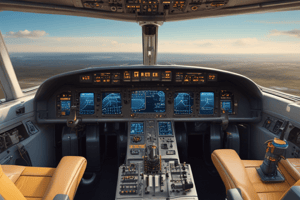Podcast
Questions and Answers
What is the primary function of the aileron force sensors?
What is the primary function of the aileron force sensors?
- To provide data to the FCCs about pilot and copilot actions to override the autopilot servos (correct)
- To translate mechanical movement into electronic signals for the FCCs
- To provide excitation signals to the transducer
- To detect the movement of the control wheel
What type of signal do the force sensors provide to the FCCs?
What type of signal do the force sensors provide to the FCCs?
- A voltage signal proportional to the applied force (correct)
- A mechanical movement signal
- An ARINC 429 data bus signal
- An excitation signal to the transducer
What is the purpose of the excitation signal provided by the FCCs to the transducer?
What is the purpose of the excitation signal provided by the FCCs to the transducer?
- To detect pilot and copilot actions to override the autopilot servos
- To provide data to satisfy flight data recording requirements
- To generate a voltage signal proportional to the applied force (correct)
- To translate mechanical movement into electronic signals
How many RVDT sensors are contained within the RVDT cluster on top of the aileron and elevator control module?
How many RVDT sensors are contained within the RVDT cluster on top of the aileron and elevator control module?
What is the purpose of the RVDT sensors?
What is the purpose of the RVDT sensors?
How many aileron force sensors are installed on the aircraft?
How many aileron force sensors are installed on the aircraft?
Which of the following CAS messages indicates a failure related to the control wheel force sensors?
Which of the following CAS messages indicates a failure related to the control wheel force sensors?
What type of data is likely transmitted on the ARINC 429 data bus to communicate control wheel force data?
What type of data is likely transmitted on the ARINC 429 data bus to communicate control wheel force data?
What is the purpose of the excitation signal in a control wheel force sensor?
What is the purpose of the excitation signal in a control wheel force sensor?
If the control wheel force sensors fail, which CAS message would most likely be displayed?
If the control wheel force sensors fail, which CAS message would most likely be displayed?
What is the typical output signal type from a control wheel force sensor?
What is the typical output signal type from a control wheel force sensor?
Which CAS message indicates a failure related to the lateral control surfaces?
Which CAS message indicates a failure related to the lateral control surfaces?
What is the purpose of the RVDTs (Rotary Variable Differential Transformers) in the provided text?
What is the purpose of the RVDTs (Rotary Variable Differential Transformers) in the provided text?
How many RVDTs provide data to each of the Flight Control Computers (FCCs) and the Backup Flight Control Unit (BFCU)?
How many RVDTs provide data to each of the Flight Control Computers (FCCs) and the Backup Flight Control Unit (BFCU)?
What is the role of the Flight Control Computers (FCCs) and the Backup Flight Control Unit (BFCU) in relation to the RVDT data?
What is the role of the Flight Control Computers (FCCs) and the Backup Flight Control Unit (BFCU) in relation to the RVDT data?
What is the purpose of the Remote Electronics Units (REUs) mentioned in the text?
What is the purpose of the Remote Electronics Units (REUs) mentioned in the text?
What is the significance of the RVDT cluster returning to neutral only if the main cluster shaft is sheared off?
What is the significance of the RVDT cluster returning to neutral only if the main cluster shaft is sheared off?
What is the purpose of the circuit breakers listed in the text?
What is the purpose of the circuit breakers listed in the text?
Explain the purpose of the aileron force sensors and how they provide data to the FCCs.
Explain the purpose of the aileron force sensors and how they provide data to the FCCs.
Describe the role of the excitation signal provided by the FCCs to the transducer in the aileron force sensor.
Describe the role of the excitation signal provided by the FCCs to the transducer in the aileron force sensor.
Explain how the RVDT sensors translate mechanical movement of the control wheel into electronic signals for the FCCs.
Explain how the RVDT sensors translate mechanical movement of the control wheel into electronic signals for the FCCs.
What type of data is likely transmitted on the ARINC 429 data bus to communicate the control wheel force data from the sensors to the FCCs?
What type of data is likely transmitted on the ARINC 429 data bus to communicate the control wheel force data from the sensors to the FCCs?
Explain the purpose of the voltage signal received by the FCCs from the aileron force sensor transducer.
Explain the purpose of the voltage signal received by the FCCs from the aileron force sensor transducer.
Describe how the RVDT sensors and FCCs work together to translate control wheel movements into commands for the aileron actuators.
Describe how the RVDT sensors and FCCs work together to translate control wheel movements into commands for the aileron actuators.
Describe the purpose of the excitation signal provided by the FCCs to the control wheel force transducers.
Describe the purpose of the excitation signal provided by the FCCs to the control wheel force transducers.
Explain how the control wheel force data is transmitted from the FCCs to the Flight Data Recorder (FDR).
Explain how the control wheel force data is transmitted from the FCCs to the Flight Data Recorder (FDR).
Describe the purpose of the RVDT (Rotary Variable Differential Transformer) sensors in the aileron and elevator control module.
Describe the purpose of the RVDT (Rotary Variable Differential Transformer) sensors in the aileron and elevator control module.
Explain the significance of the RVDT cluster returning to a neutral position if the main cluster shaft is sheared off.
Explain the significance of the RVDT cluster returning to a neutral position if the main cluster shaft is sheared off.
What is the purpose of the ARINC 429 data bus in transmitting the control wheel force data from the FCCs?
What is the purpose of the ARINC 429 data bus in transmitting the control wheel force data from the FCCs?
Describe the relationship between the control wheel force sensors and the Autopilot (AP) system.
Describe the relationship between the control wheel force sensors and the Autopilot (AP) system.
What is the role of the cockpit sensors in the GULFSTREAM G650ER system?
What is the role of the cockpit sensors in the GULFSTREAM G650ER system?
How are commands generated for moving flight control surfaces in the GULFSTREAM G650ER?
How are commands generated for moving flight control surfaces in the GULFSTREAM G650ER?
What do the force transducers below the control wheels measure in the GULFSTREAM G650ER?
What do the force transducers below the control wheels measure in the GULFSTREAM G650ER?
What prompts the Remote Electronic Units (REUs) to energize actuators in the GULFSTREAM G650ER system?
What prompts the Remote Electronic Units (REUs) to energize actuators in the GULFSTREAM G650ER system?
How is control wheel force data likely transmitted on the ARINC 429 data bus in the GULFSTREAM G650ER?
How is control wheel force data likely transmitted on the ARINC 429 data bus in the GULFSTREAM G650ER?
What type of signal do the force sensors provide to the Flight Control Computers (FCCs) in the GULFSTREAM G650ER system?
What type of signal do the force sensors provide to the Flight Control Computers (FCCs) in the GULFSTREAM G650ER system?
Flashcards are hidden until you start studying
Study Notes
Aileron Force Sensor and Control Module
- Two aileron force sensors are installed, one in the pilot's aileron and elevator control module and one in the copilot's aileron and elevator control module.
- The sensors provide data to satisfy FAA/EASA flight data recording requirements and detect pilot and copilot actions to override the AP servos.
- Each sensor is a two-channel strain gauge that connects to FCC No. 1 and FCC No. 2.
- The FCCs provide an excitation signal to the sensors and receive a voltage signal back that is proportional to the applied force.
RVDT Cluster and Control Module
- The RVDT cluster contains five RVDT sensors on top of the aileron and elevator control module.
- The RVDT sensors translate mechanical movement into electronic signals sent to the FCCs.
- The FCCs interpret the electronic signals from the RVDTs and send commands to the REU aileron actuators.
- The pilot and copilot control wheel position is measured by the RVDTs.
- Each position sensor contains a common shaft along the vertical center line that simultaneously drives all five RVDTs.
System Overview
- The system uses multiple dedicated position sensors connected to the control wheels, control columns, and rudder pedals for each pilot station.
- Cockpit sensors generate electronic signals and send data to the FCCs, BFCU, AP system, and FDR.
- Commands are based on cockpit control displacement produced by the pilot, copilot, or AP system servos.
- The FCCs and BFCU provide excitation signals to RVDT and force sensors and receive voltage signals back that are proportional to the applied force and position.
Component Location
- Aileron force sensor: 2, located in the forward right side of the aileron and elevator control module.
- Aileron control module RVDT: 2, located on top of the aileron and elevator control module, right side.
Circuit Breakers and Power Source
- The system is protected by multiple circuit breakers and solid-state power controllers.
- Power sources include 28VDC from L ESS, R ESS, L MAIN, and R MAIN.
CAS Messages
- Multiple CAS messages are displayed, including FCS Maintenance Required, Roll Control Miscompare, and others.
- Messages indicate system failures, miscompares, or maintenance requirements.
Studying That Suits You
Use AI to generate personalized quizzes and flashcards to suit your learning preferences.



